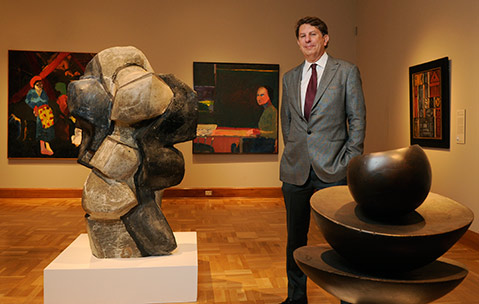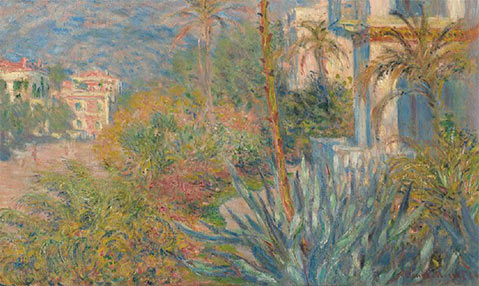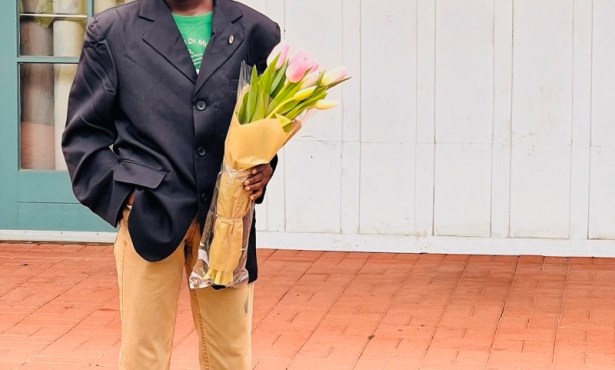Santa Barbara Museum of Art’s 75th Anniversary
Downtown Cultural Hub Celebrates With Exhibit of Recent Acquisitions

It was 75 years ago this June that the old post office building on the corner of State and Anapamu streets first opened its doors as the Santa Barbara Museum of Art. The construction inside remained partly unfinished, but there were 1,500 junior high school students waiting patiently on the steps, because founder Buell Hammett had consulted an astrologer who assured him that, at 11:43 in the morning on June 5, the stars would be aligned in the most propitious way possible for the start of this new venture. Regardless of whether or not the stars had anything to do with it, June 5, 1941, was indeed a lucky day, for Santa Barbara’s new museum would prove to consistently deliver experiences far out of proportion to the size of the population it serves.
As the museum gears up for its 75th anniversary celebration beginning on Sunday, May 15, it is time to tell again the fascinating story of how it became one of the top regional art museums in the world. Walking through the splendid new exhibit from the Indian subcontinent, Puja and Piety, it’s easy to feel the deep connection between the museum’s cosmopolitan outlook and the life of our city. But it is through the adjacent selection of works from the permanent collection, 75 in 25, and its introductory essay by the museum’s director Larry Feinberg, that one can learn how this seemingly natural and effortless fit between institution and community came about through the hard work and dedication of several generations.
The early years were necessarily marked by the historical circumstance of the Second World War. As the museum’s first director, Donald J. Bear, was selecting works for the inaugural show, Painting Today and Yesterday in the United States, the Japanese navy was preparing to attack Pearl Harbor. To enter the building through the Ludington Court, then as now home to magnificent examples of Greek and Roman sculptures, and to proceed into an exhibition 140 images strong demonstrating the vitality and range of American art was to witness firsthand the living tradition that the war was being fought to protect. Yet from its very beginning, the Santa Barbara Museum of Art also recognized and honored the multiplicity of artistic expression and the diversity of cultures that come together here in California. When the large McCormick Gallery opened in 1942, among the first shows were major exhibitions of pre-Columbian art and modern paintings from Mexico.

Despite the difficulties presented by life during wartime, the museum nevertheless managed to expose the people of Santa Barbara to the most important developments in modern art. Imagine the impact visitors must have felt when Picasso’s giant anti-war painting “Guernica” went on display in May of that year, or the excitement generated later that same spring when the museum exhibited the “Nude Descending a Staircase” of Marcel Duchamp. These are just two examples of the level of work that curators were able to borrow from the start.
After the war, the pace of exhibition planning accelerated, and Santa Barbarans enjoyed a front-row seat for the period that came to be known as “the triumph of American painting.” For example, the museum presented the work of Mark Rothko in 1946, identifying the artist on the cusp of shifting to his signature style. With the unexpected loss of Bear, who died of a heart attack in March 1952, the museum entered into a new era in which his successor, Ala Story, would both continue in his pattern of support for California artists and expand the museum’s holdings of European and Asian art.

As a result of Story’s initiative, the museum began holding the Pacific Coast Biennial, an invitation-only exhibition of artists handpicked by the new director on her many excursions to studios in California, Oregon, and Washington. As a result, the museum began buying work by rising stars. One brilliant example of a work acquired as a result of the Biennial series is Richard Diebenkorn’s “Woman and Checkerboard” (1956).
When Story retired in 1957, her successor, James Foster, took over and revolutionized the permanent collection through the acquisition of the Preston Morton Collection of American Art in 1960. Suddenly, this small museum on the West Coast was in possession of works by artists associated with cities such as Boston, Philadelphia, and New York, including John Singleton Copley, Alfred Albert Bierstadt, William Merritt Chase, and John Singer Sargent, and such later masters as Marsden Hartley and Edward Hopper. The core of a remarkable collection of American art was now fully established.
The period that followed, from 1963 to 1982, in which Thomas Leavitt and then Paul Mills directed the museum, will always be remembered as among its most exciting. Leavitt was from Boston by way of Pasadena, where he had staged the first Duchamp retrospective in America. This epochal event remains central to any genealogy of modern art on the West Coast, and Leavitt continued to pursue the cutting edge in his position in Santa Barbara with exhibits by Piet Mondrian, Philip Guston, and sculptor Tony Smith. Following on Leavitt’s pattern of concept-driven group shows such as Optical Paintings in 1966, Mills, who became director in 1970, pushed further in this direction with exhibitions like 1971’s Spray, which brought together artists using various spray-painting techniques.
The 1990s and the 2000s have seen the Santa Barbara Museum of Art operating at its highest level yet of scholarly productivity and community outreach. Thanks to a grant from Lord Paul and Lady Leslie Ridley-Tree, the museum continues to offer an extraordinary range of educational activities to thousands of students throughout the county. Under Feinberg, whose officially endowed title is Robert and Mercedes Eichholz Director, the curatorial staff has grown into a formidable center of art historical scholarship, with Asian Art curator Susan Tai recently honored for her spectacular catalogue for the show The Artful Recluse.
As it enters into this 75th year, the museum has never been in better shape, or had more to offer to the city.



